Autocar is playing host to an MG Cyberster for the next few months, and I’m to be its custodian. This is a £60,000, battery-powered, two-seat roadster that goes from 0-62mph in 3.2sec and has electrically operating scissor doors.
How far back in time would we have to travel before it would seem daft that a Chinese manufacturer might attempt to make a car as exotic and glamorous as this? I might suggest not very.
I thought comedian Denis Leary said this, but the internet tells me it was PJ O’Rourke, who wrote in 2010: “There are 1.3 billion people in China, and they all want a Buick.” Well, now there are 1.4 billion Chinese, and they don’t all want a Buick; they want to make something better than a Buick.
In 2010, China was already making more cars than any other country in the world; now it’s three times as many as the world’s next most productive country, but more Chinese cars are domestic brands, not joint ventures with Western car makers. That stage is over.
MG is unusual here, because while it is now a domestic brand, owned by SAIC, the Chinese state-owned maker, it still plays on its British heritage, both here and there, and it retains design and engineering offices in the UK.
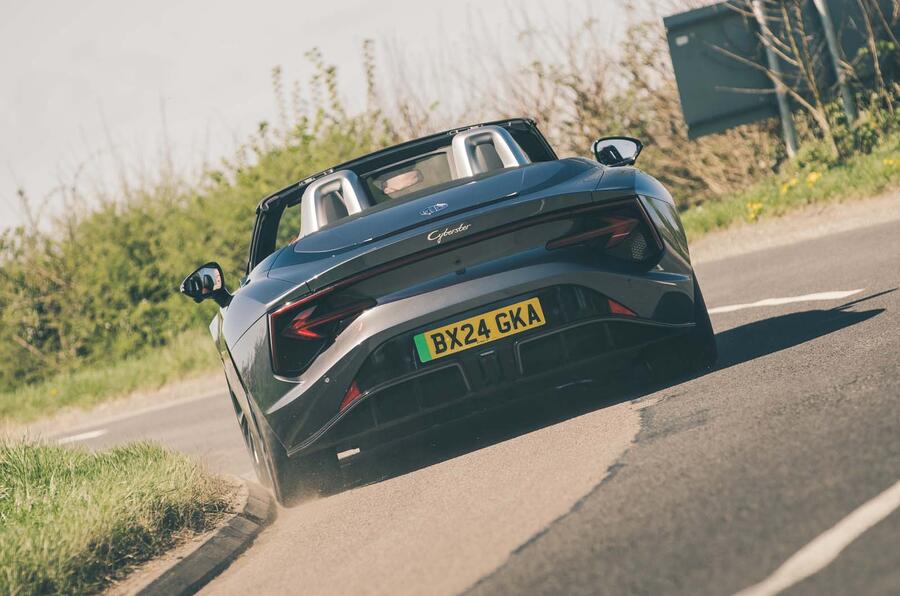
In China, where you can buy a dual-motor Cyberster for £40,000, they even use an MGB roadster alongside it in adverts. This dual-motor Cyberster, called the GT, sits at the top of a simple two-model range.
The base car, the Trophy, has a single rear motor and 335bhp to give it a 0-62mph time of 5.0sec. The GT, though, supplements that with a motor driving the front wheels too for a system total of 503bhp and that sparkling 0-62mph time.
It retails at £59,995 and, like the £54,995 single-motor version, comes with the works: if you’re looking for options, there’s metallic paint at £545 or £595 and a £500 red hood option alongside some paint colours (but not red or yellow, presumably on grounds of taste).
There are two interior colour options, grey or red, both at £0. This one is red, and it’s rather restrained. And that’s it. MG is not one to make you delve into an options list. There is one wheel choice (20in alloys with Pirelli P Zero tyres, 245/40 fronts, 275/35 rears), heated seats, heated steering wheel, electric seats, electric hood, electric doors, a Bose stereo, adaptive cruise control, vehicle-to-load capability and more ADAS than are mandatory.
I’ll expand on the ADAS another time, because the attention assist function is the worst performing of the lot and seemingly the only one that can’t be switched off.
Both variants of the Cyberster have a 74.4kWh (usable) battery capacity, and this GT a 3.2mpkWh combined-cycle rating with a 276-mile WLTP range. I’m seeing more like 250, but I’ll keep an eye on it.
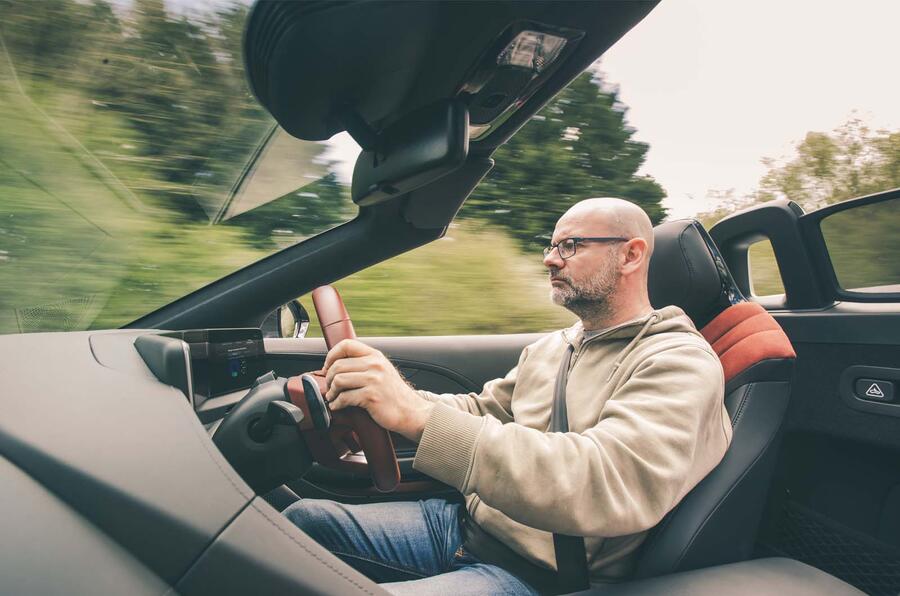
Its maximum charge speed is 144kW, but so far I’ve charged it only at home. I’ll keep an eye on that, too. The MG will take some getting used to. There is an instrument binnacle, a screen either side of it controlled via steering wheel buttons and a central touchscreen, with functions spread throughout.
There are steering wheel paddles, the left for changing the retardation rate, the right for flicking through drive modes, which include a custom one: you can choose drivetrain and steering response.
In default Comfort mode the car only uses the rear motor, I think, given more leisurely acceleration and slight rear-wheel scrabble on driveway exit; sportier modes introduce the front motor and up the responses until they’re at pretty remarkable levels in Track mode.
The chassis does its best to keep up. This is a heavy car, particularly for a two-seater of, by today’s standards, reasonable proportions, being 4.54m long by 1.91m wide (2.1m including mirrors).
It’s 1985kg at the kerb (the single-motor variant is a full 100kg lighter), so the non-adjustable, passively damped suspension has the unenviable job of both keeping on top of body movements and retaining the kind of ride compliance MG would like the Cyberster to have.
MG does talk of “uncompromising power and performance”, but at the same time this version is called GT, and the company mentions giving “the grand touring experience”.
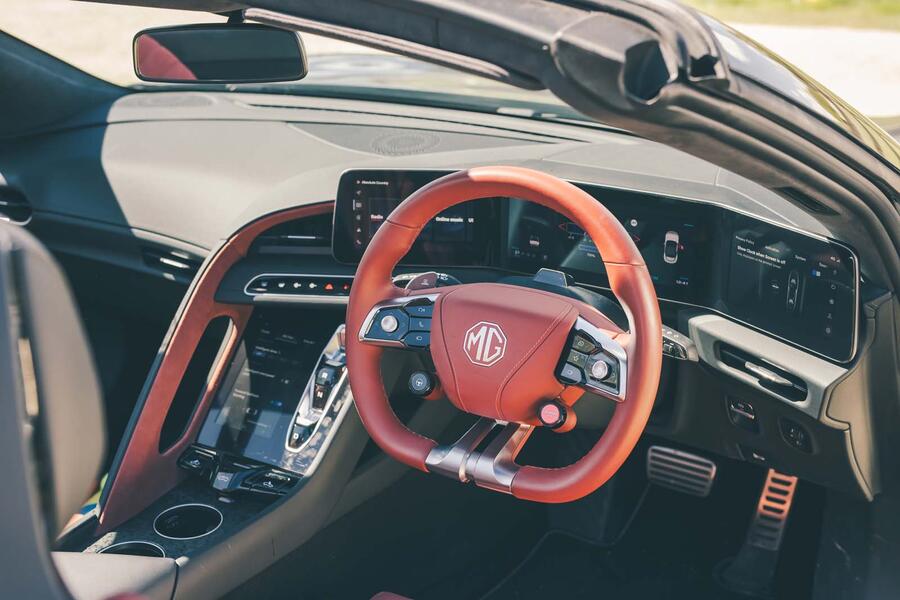
That’s a fine path to tread with relatively unsophisticated underpinnings. I haven’t tried a single-motor car, which the testers say is softer; I haven’t quite decided which way, if either, I’d want this to go. Big surface undulations generate some heave, but pitch and roll are well contained. The centre of gravity is low, after all.
That there are batteries beneath you means you don’t feel nestled deep into the interior, but neither do I feel like I sit precariously on top of it, like our taller testers did.
The fact that we have a car like this at all, though, and that MG is the first one to give it to us, shows how far the company has come and how fast. How quickly this car works its way into our affections, we’ll find out.
Update 2
I almost knew it would be a bad idea to leave the MG Cyberster unplugged in a car park for a week. We’ve received enough letters about (some) EVs and PHEVs conking out when left for extended periods that I nearly took an old diesel to the airport instead. But don’t be so silly, I told myself – it’ll be fine. And if it’s not, that’s the point of trying it.
It wasn’t fine. On my return I pressed the key fob and, sure enough, nothing happened. Not a peep of sound, not a flash of lights nor the merest hint that the car knew I was standing next to it, apoplectic, trying to unlock it.
I pressed the button again, and again, then all the other buttons on both car and remote, repeatedly and exhaustively – sometimes simultaneously – even though I knew it wouldn’t make a difference. The car had enough electrical power in it to drive to Nottingham, but not enough to open the doors.
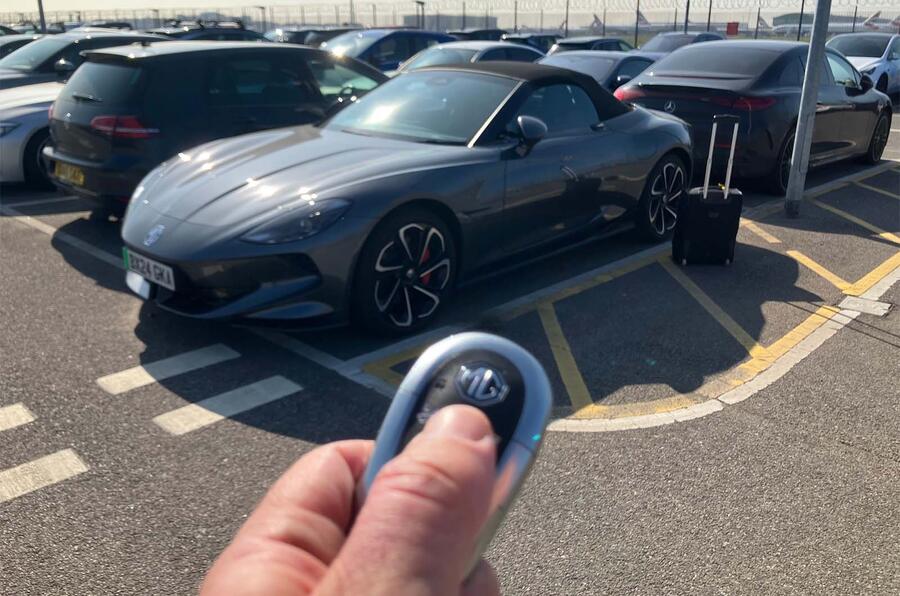
This is apparently a thing with some EVs. They have a very large high-voltage drive battery but, like all cars, also a 12V system that runs everything else.
If the 12V battery on an ICE car is low, it will at least have a go at spinning the engine into life so it can charge from the alternator. If the 12V battery on an EV is low, it won’t dare try to connect the big switch to the high-voltage system.
Some EVs will keep an eye on themselves and periodically connect to the high-voltage system to top up the 12V battery. Others, apparently like the MG, do not.
I needed access to the 12V battery. Some cars have a physical key within the remote so you can at least open a door. The Cyberster doesn’t. Its door and boot buttons are electrically operated, so in the event of a flat 12V you can’t get into the cabin. And as well as being where you left your house keys, that’s where you’ll find the bonnet release to access the 12V battery.
Mercifully, MG’s techs have a workaround: behind one of the front bumper’s towing eye access panels is a wire pull that unlatches the bonnet, so you can get under there, if not to your house keys.
With bonnet up and terminals located, I phoned the car park operator who kindly sent a man in a van with a 12V jump pack, but it wasn’t quite good enough to coax the Cyberster into life.
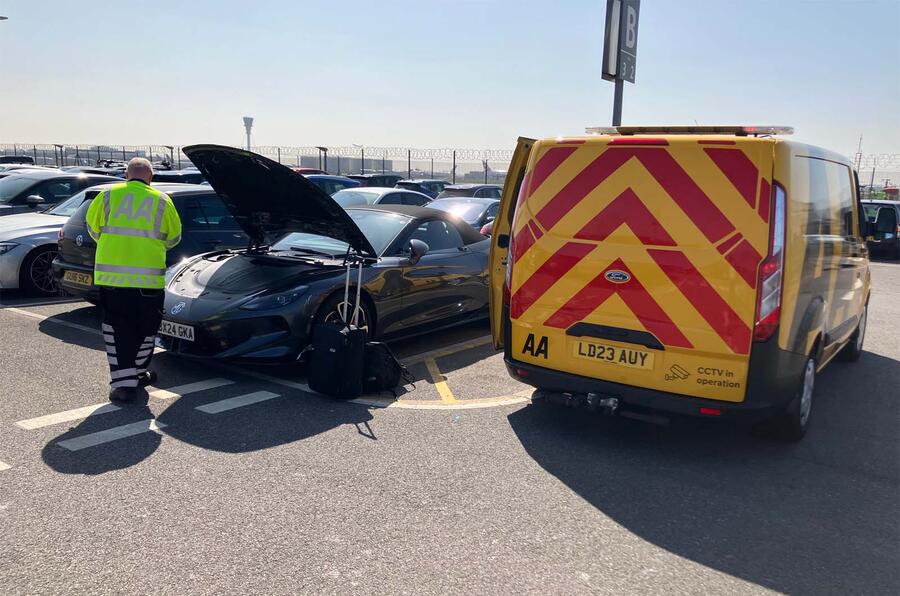
So I called the AA, and after a short wait a very, very nice man called Simon (who remembers the old ‘very very nice man’ AA ads but was too polite to say he’s tired of hearing about them) arrived with an ammeter and a fully juiced jump pack.
Diagnosed and with the pack connected, the MG sparked into life, opened its door on command, quickly threw up about three dozen error messages and then got over itself and behaved normally.
Simon has come across this problem before but hadn’t seen the secret bonnet release, a tip that, via the AA grapevine, will now be more widely known. And thanks to Heathrow’s car park, which quickly sent help and confirmed there would be no charge for overstaying, or for the AA.
The car has been fine since, but I know one long-haul pilot who has cancelled a Cyberster order as a result of the tale.
Update 3
As I write, it’s quite warm and dry out so I’ve been popping the roof down on the Cyberster as often as not. This doesn’t take long, and can be done at up to 28mph, which means if it gets too toasty for my wee baldy heid, I can put it back up again without much bother.
I’ve had a letter or two about the driving position, because the MG’s is relatively high in the roadster scheme of things: the battery is underneath the floor, so you can feel like you’re sitting more on than in the car.
Mind you, the MGF had a similar issue and this car does say ‘100th anniversary’ on the side. I’m not sure it’s a deliberate intention to continue that part of the MG heritage, but still. It feels on-brand.
I don’t find the driving position such a bother as one reader, shorter than I am, who simply couldn’t put up with it. I’m 5ft 10in and my head isn’t into the headlining with the roof up, and I’m looking cleanly underneath the screen’s header rail with it down. Maybe I have the seat more reclined?

It’s something worth considering if you’re thinking about a Cyberster, though, particularly if you are tall, because as in, say, a Jaguar F-Type, the seat doesn’t slide so far back, and the further back you go the less reclined you can have it.
Anyway, what this means for me is that, roof down, the wind isn’t too much in what was once hair. I get that pleasing open-air feeling, the ability in traffic to look up at passing aeroplanes or red kites, without too much buffeting.
There’s a wind deflector and I’ve been leaving it in place because it’s not hard to look through it via the interior mirror. It’s like looking through a fine fly screen or something like that.
It sits between the two roll bars and can easily be pulled free, or relocated, with one hand. So if it bothers you, it’s a doddle to get it out of the way. It’s even marked ‘front’ on, er, the front, so you know which way around it goes when it comes to putting it back quickly.
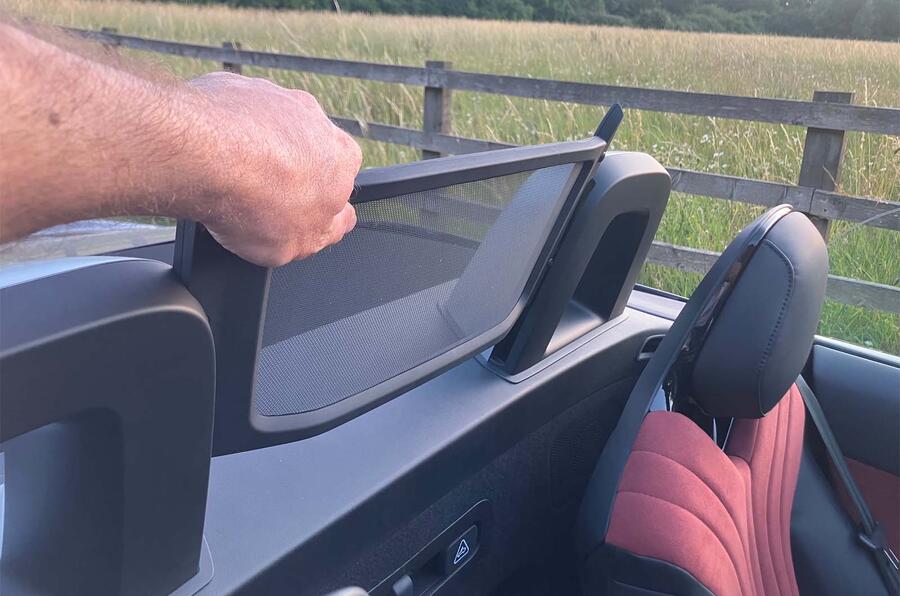
I wouldn’t recommend trying to put it back in place on the move, but you can easily pull it free while driving, although with roof down I’m not sure you’d want to.
Having it in place doesn’t make too much difference to the amount of buffeting around your head, but it does seem to reduce the amount of turbulence swirling around in the middle of the cabin, curiously. Without it in, I’d want to secure any valuable receipts. Keeping the side windows up also considerably reduces turbulence, so unless
I’m mooching around town, I tend to keep those up too. The easiest stowage for the deflector is probably in the netted cargo area behind the seats.
It’s where the emergency manual handles for the otherwise-electric door releases are too. You couldn’t fit a set of golf clubs back there, but for oddments stowage it’s a handy ‘accessible, but not in the cabin’ space for things you might normally put in the door pockets.
It does have those too. It’s just that they’re small and they snap shut, because the doors raise through 90deg and it would throw my sunscreen and window cleaner onto the floor if they had conventional door pockets. Actually, for a two-seat roadster overall, luggage volume is pretty good.
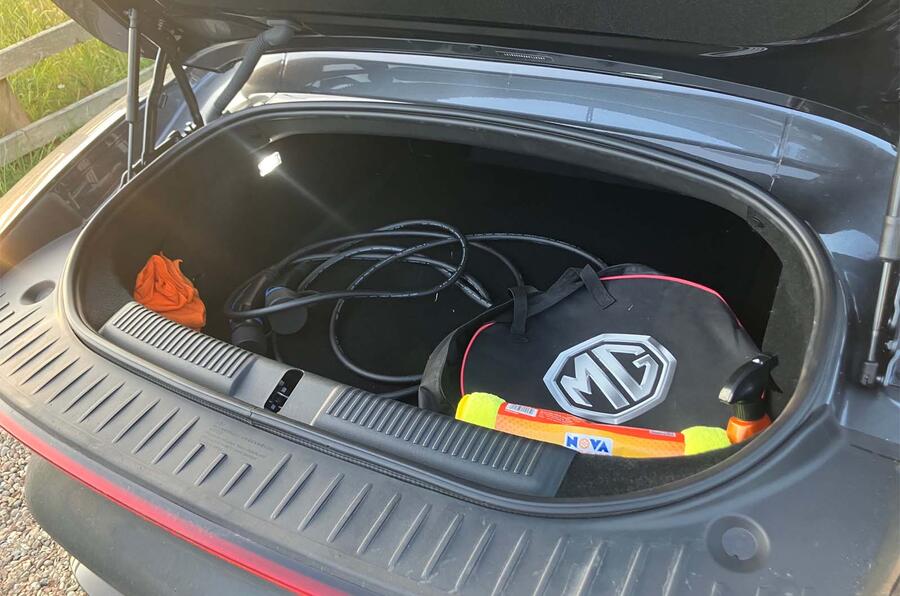
The boot, if not deep, is quite long, and while all you’ll find under the bonnet is a vast black plastic shield with compartments for fluids and battery, it’s not like anything with an engine has space there either.
Having the roof down, or the audio up loud, also means there’s more ambient noise kicking around so you can’t hear some of the MG’s more irritating chimes and bongs.
I’ll expand on those another time because I think they deserve a report of their own.
Update 4
As I briefly caught sight of the rear of a metallic grey roadster while viewing a page on the internet, I wondered why ‘my’ MG Cyberster was being photographed and written about.
My mistake: it was a picture of the rear of the new Aston Martin Vanquish Volante. On anything more than a glancing cursory inspection, the two of course don’t look like each other, but in a week when MG has also launched a 742bhp super-saloon, I do get a sense that the old rules about who makes quick and expensive and glamorous cars and who does not are presently being rewritten.
I recently took the Cyberster along to a photo and video shoot in Wales to meet a different Aston Martin, a Vantage Roadster, plus a McLaren Artura and a Ferrari Roma. The MG wasn’t part of the test: these are luxury sports cars with mighty engines. But if you take a look at the picture above, does it look so out of place?

Well, it is a bit out of place, ultimately. Look closer and you will see a sensor on the electrically opening door, supposedly subtle, but, like a shell hole amidships, it’s very noticeable and often one of the first things people talk about when they look at the car.
The headlights, too, instead of being some multiple-billion LED set-up, are relatively conventional, but then they are backed with some etching so they look more technically complex than they are.
And on the boot sill there’s a note that seemingly hasn’t been beyond one round of Google Translate: ‘NOTICE! Please do not place heavy objects and don’t seat,in order to avoid damage to vehicle parts.” Bad English aside (missing space after the comma included), isn’t it odd that you can’t sit on a boot lip?
None of these things is overtly annoying, though, unlike my biggest beef with the Cyberster: its driver attention monitor. Unlike all of its other GRS2 safety-regulation-mandated ADAS components, this is one that can’t be switched off, and yet it’s the one that works the worst.
The theory – and damn whoever made this mandatory – is that a camera on top of the steering column monitors your eyes and tells you if you’re not paying attention to the road, via a chime and a dashboard notice.
The rulebook says for how long you can look away before the warning appears. The trouble is that here it works appallingly. Perhaps it’s because I’m wearing glasses, but I suspect not.
Glance at the temperature switches to increase fan speed? Ding! ‘Please focus on driving.’ Driving down a slip road looking in the mirror? Ding! ‘Please focus on driving.’ Just viewing a mirror to plan a motorway overtake? Ding! ‘Please focus on driving.’ Looking at length into the driver’s footwell in search of a lost jelly baby? Nothing.
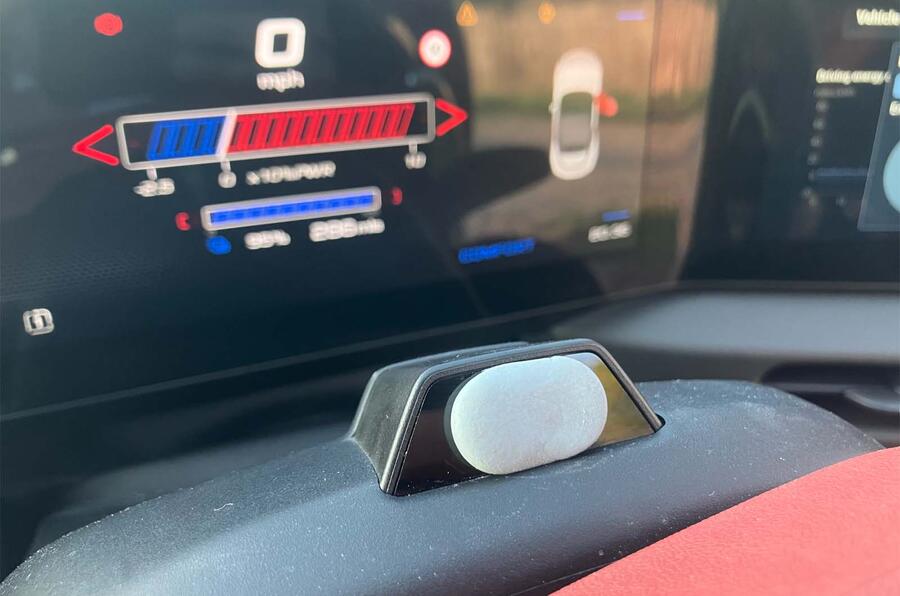
Worse, even if dinged into submission, so staring resolutely straight ahead and ignoring the safer option of checking your surroundings, the heckling chimes can continue for some time afterwards. It’s truly awful.
The saving grace is that if the audio is loud or the roof down you probably don’t hear it, at least not if it’s just a single chime. And that’s what I’ve reduced the system to, after trialling a few other options, including sticking a passport photo of myself to the steering wheel boss. It seemed to work briefly, but in a constant-radius bend the car thought I was falling out of my seat.
The answer, then, came in the high-tech form of a piece of Blu Tack over the camera. Now every time I slow down the car gives a single ding and says the camera is blocked, but it’s only a single ding. Around town, where the system is slightly less erroneously insistent, I sometimes remove it.
As a result, I’m experiencing something of a like-loathe relationship with the Cyberster. That it’s fitted with this system isn’t MG’s fault, but that it works this badly and can’t be switched off is.
Final report
It’s normal for a new car to generate a certain level of interest, but I have never run a car that has prompted such divisive reaction as the MG Cyberster.
I’ve had correspondents say they absolutely love theirs and that it’s much better than the combustion-engined European convertibles it replaced; others say they sold or returned theirs after not getting on with it at all.
I’ve had a shorter driver say he felt seated too high to buy one but a taller one think it was fine, while one reader (presumably not an owner) even told me to “eat shit” at 1am on a Sunday because we acknowledged MG’s success at our awards. Swings and roundabouts, I suppose.
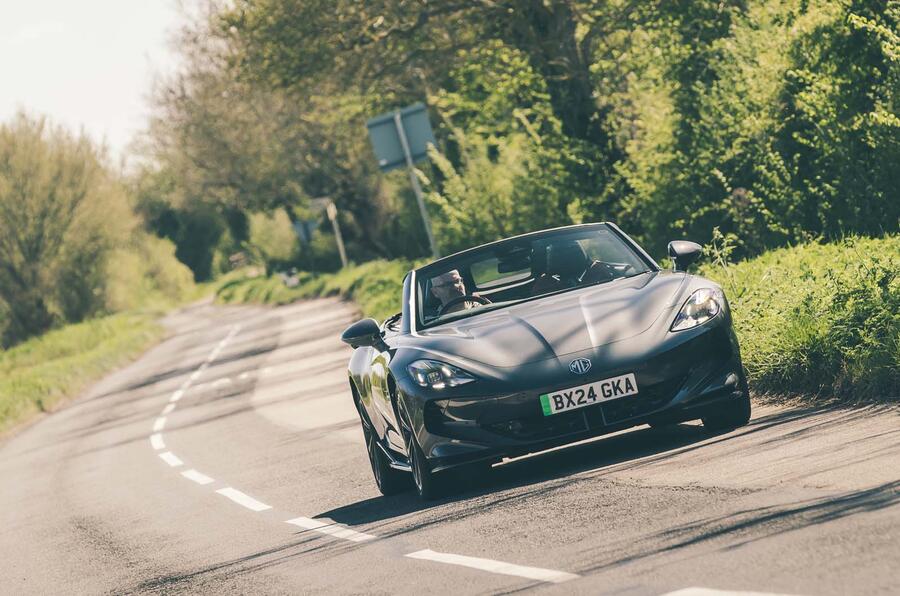
After spending 3000 miles over a few months in the Cyberster, I’m still slightly conflicted about my own thoughts on it. I like the fact that any manufacturer, let alone a mainstream one, has come up with a fast electric roadster that looks as good and drives as convincingly as this.
But it has foibles that I couldn’t live with if it were my own car, and I don’t think it’s a particularly good idea for us all to buy cars from Chinese state-owned car makers if we value having European ones – although why this seemingly bothers us so much about cars while it doesn’t in other industries is a discussion for another place.
So to the details. The Cyberster arrived with us in its range-topping GT form. The single-motor base version is called the Trophy, while this twin-motor top car is the GT, which cost £59,995 at the time of arrival but is £60,245 now.
Mechanically, it’s a relatively straightforward proposition. The Trophy gets only a 335bhp rear motor, while the GT adds a front motor for a system total of 496bhp and a 0-62mph time of 3.2sec.
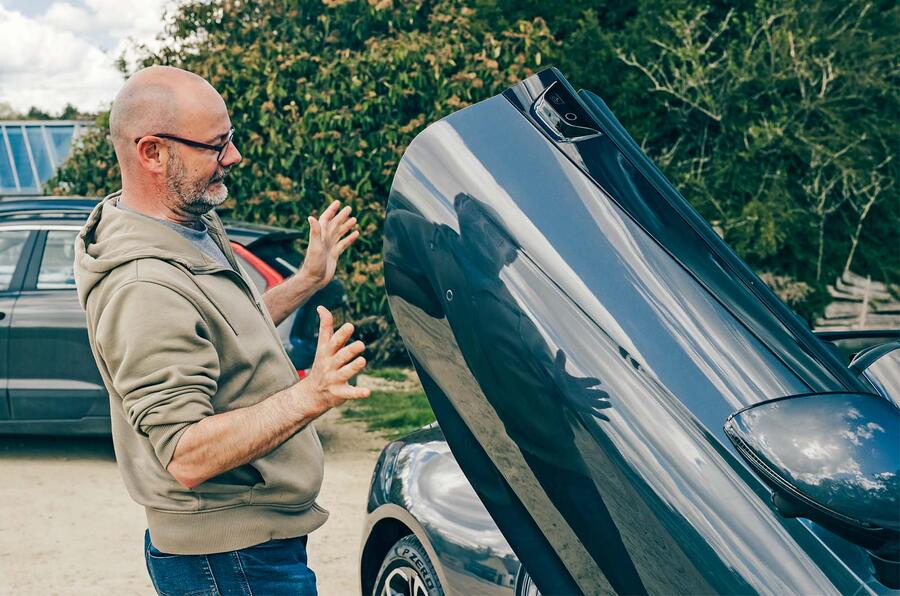
It has, like the Trophy, a 74.4kWh usable battery capacity. It also has a combined cycle rating of 3.2mpkWh and a range of 276 miles, which in warmer weather and moderate driving I’ve found the Cyberster can better and in cooler weather and faster driving it will not.
Overall I matched the WLTP figure, because I ran the car over summer and used it for a lot of pootling about. Over a longer period I might not have. It comes with a lot of kit and not very many options. There are only two interior colour options, grey or red, both £0, plus one wheel choice, metallic paint and a red hood option.
The only option on this car is the £545 metallic paint. It has heated seats and steering wheel, electric hood, electric doors, a Bose stereo, adaptive cruise control, vehicle-to-load capability and more.
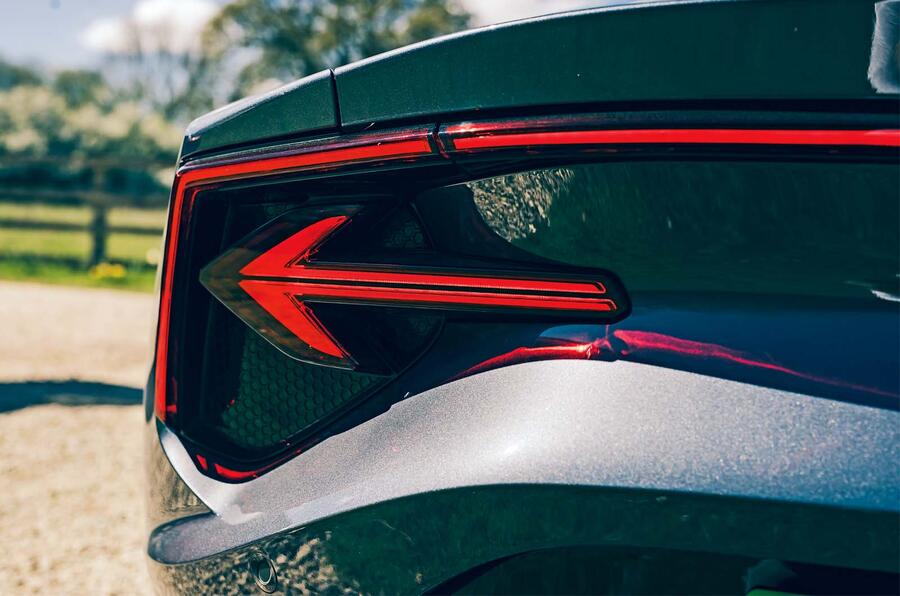
They don’t make you take out a subscription for additional power or heated seats or any of the assistance systems. The practice is back in the news from European car makers, and it’s ghastly and customers hate it, so is it any wonder that people will buy an MG instead? This car comes kitted out and that’s that.
I would, however, have preferred manual doors to the electric ones, because they would be quicker, they wouldn’t have unsightly sensors on the side and, when I left the car for a week in a car park and the 12V battery went flat, I could have had a physical key to at least gain access to the cabin.
If the car is immobile, you have to reach the 12V battery terminals by popping the bonnet via a cable behind the bumper. Some EVs and PHEVs allow their 12V systems to hook up to the high-voltage battery (which in my case still had about 70% charge) to keep themselves topped up, but this MG doesn’t.
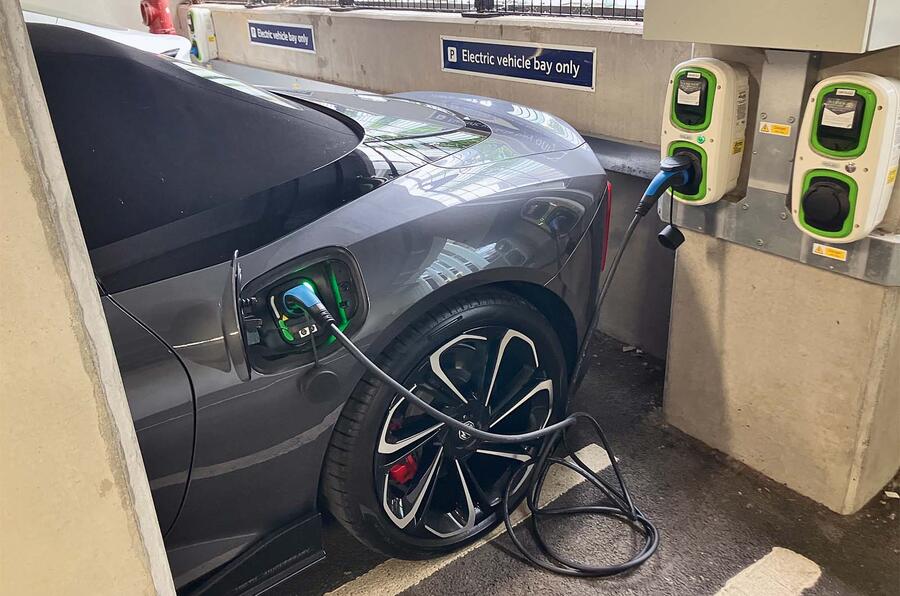
I know one reader, a pilot who often leaves his car at airports, who cancelled an order as a result. Some of the Cyberster’s mandatory equipment is irritating too. It’s not MG’s fault that it has an ADAS suite, but it is to blame for the fact that the driver attention monitor bongs that I’m not paying attention when I very much am and that you can’t switch that system off.
An owner, though, says he hasn’t seen a similar message in 10 months of owning his car. Could be it’s my glasses, but making the system switchable would solve the issue.
Those things are very annoying (the bongs mean I couldn’t live with the car) but they are the Cyberster’s only genuine foibles. I found the seat had too much lumbar support but otherwise got on fine with the driving position.
With the audio up or the roof down the chimes of doom are harder to hear, and at those times I found the car easy to like. It has smooth steering, a relaxed if too-loose ride on undulating roads and, in its sportier drive modes, really urgent pace.
The short of it is that while we’ve lived with one, I think you still really need to try one yourself. You might love it, you might hate it or, like me, you might swing between the two.
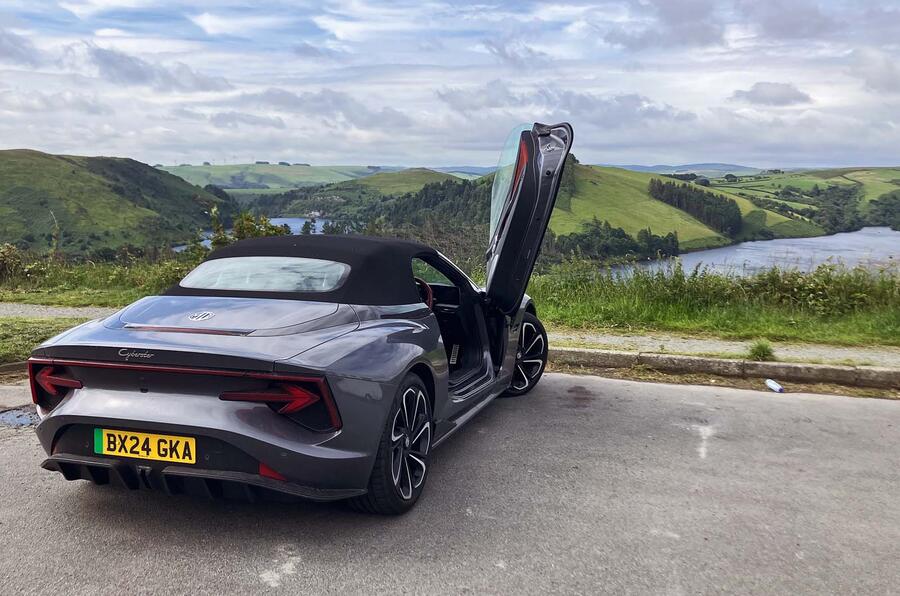
MG Cyberster GT specification
Prices: List price new £59,995 List price now £60,245 Price as tested £60,540
Options: Camden Grey Metallic Paint, £545
Fuel consumption and range: Claimed range 276 miles Battery size 74.4kWh Test average 3.2mpkWh Test best 3.7mpkWh Test worst 3.1mpkWh Real-world range 240 miles
Tech highlights: 0-62mph 3.2sec Top speed 125mph Engine Two permanent magnet synchronous motors Max power 496bhp Max torque 535 lb ft Transmission 1-spd reduction gear, AWD Boot capacity 249 litres Wheels 8.5Jx20in (front), 9.5Jx20in (rear), alloy Tyres 245/40 R20 (front), 275/35 R20 (rear), Pirelli P Zero Kerb weight 2210kg
Service and running costs: Contract hire rate £850psm CO2 0g/km Service costs None Other costs None Fuel costs £278 Running costs inc fuel £278 Cost per mile 9pence Faults Flat 12V battery

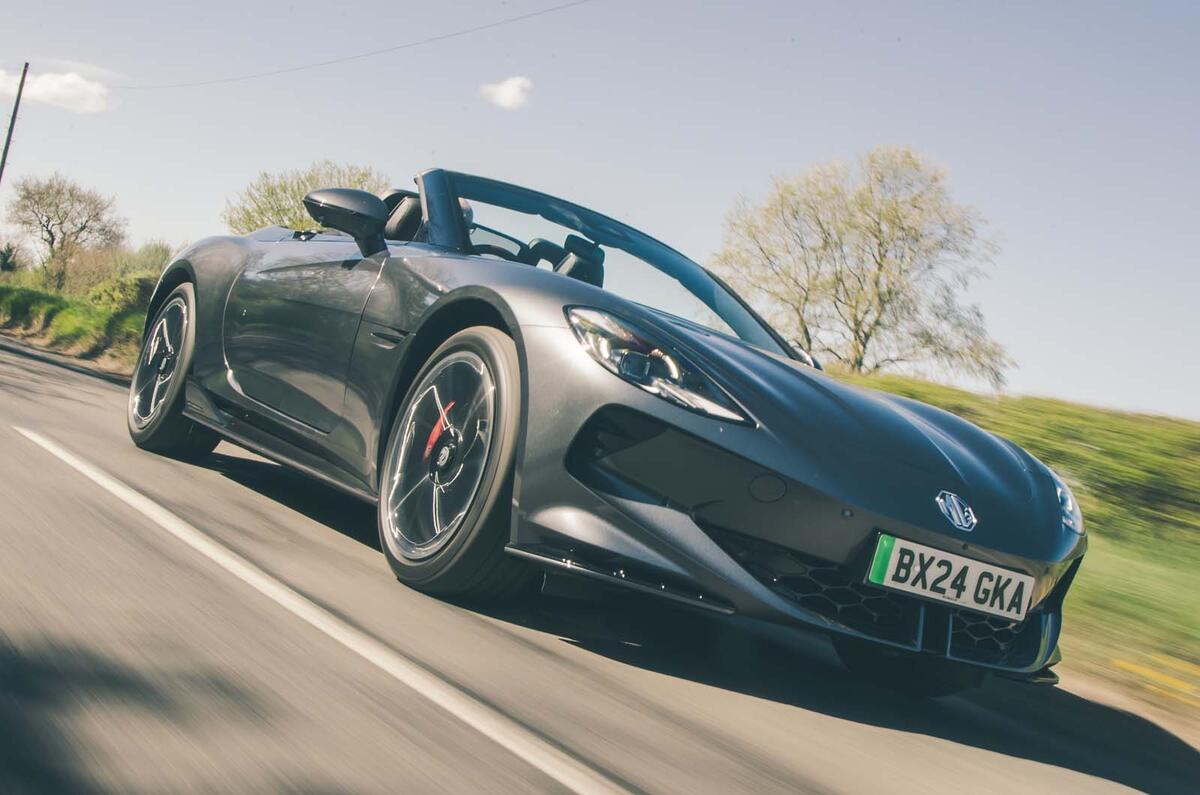


Add your comment